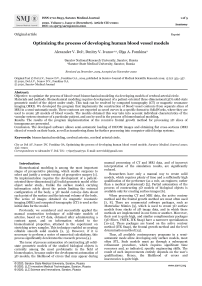Optimizing the process of developing human blood vessel models
Автор: Alexander V. Dol, Dmitry V. Ivanov, Olga A. Fomkina
Журнал: Saratov Medical Journal @sarmj
Статья в выпуске: 2 Vol.1, 2020 года.
Бесплатный доступ
Objective: to optimize the process of blood vessel biomechanical modeling via developing models of cerebral arterial circle. Materials and methods. Biomechanical modeling requires development of a patient-oriented three-dimensional (3D) solid-state geometric model of the object under study. This task can be resolved by computed tomography (CT) or magnetic resonance imaging (MRI). We developed the program that implements the construction of blood vessel contours from separate slices of MRI in a semi-automatic mode. These contours are exported as saved curves in a specific format to SolidWorks, where they are used to create 3D models of blood vessels. The models obtained this way take into account individual characteristics of the vascular system structure of a particular patient, and can be used in the process of biomechanical modeling. Results. The results of the program implementation of the recursive frontal growth method for processing 2D slices of tomograms are presented. Conclusion. The developed software allows semi-automatic loading of DICOM images and obtaining flat cross-sections (MRI slices) of vessels on their basis, as well as transferring them for further processing into computer-aided design systems.
Biomechanical modeling, cerebral arteries, cerebral arterial circle
Короткий адрес: https://sciup.org/149135011
IDR: 149135011 | DOI: 10.15275/sarmj.2020.0201
Список литературы Optimizing the process of developing human blood vessel models
- Trushel NA, Mansurov VA. Mathematical modeling of blood flow in the area the internal carotid artery split into terminal branches. In: Morphology as a science and practical medicine: Compilation of scientific publications dedicated to the 100th anniversary of N.N. Burdenko Vitebsk State Medical University. Vitebsk 2018; 377-83. (In Russian).
- Fomkina OA, Ivanov DV, Kirillova IV, Nikolenko VN. Biomechanical modeling of cerebral arteries under different configuration variants of vertebrobasilar system intracranial arteries. Saratov Journal of Medical Scientific Research 2016; 12 (2): 118-27. (In Russian).
- Fomkina OA. Regularities of individual typological variability in morphometric and biomechanical parameters of cerebral arteries: DSc diss. Saratov 2017; 240. (In Russian).
- Ivanov D, Dol A, Pavlova O, Aristambekova A. Modeling of human circle of Willis with and without aneurisms. Acta Bioeng Biomech 2014; 16 (2): 121-9. https://pubmed.ncbi.nlm.nih.gov/25088007/
- Shao H, Qin H, Hou Y, et al. Reconstructing 3D Model of Carotid Artery with Mimics and Magics. Advances in Information Technology and Education 2011; 201: 428-33. https://doi.org/10.1007/978-3-642-22418-8_61
- Drapikowski P, Domagala Z. Semi-automatic segmentation of CT/MRI images based on active contour method for 3d reconstruction of abdominal aortic aneurysms. Image Processing & Communication 2014; 19 (1): 13-20. https://doi.org/10.1515/ipc-2015-0002
- Fresno M, Venere M, Clausse A. A combined region growing and deformable model method for extraction of closed surfaces in 3D CT and MRI scans. Computerized Medical Imaging and Graphics 2009; 33: 369-76. https://doi.org/10.1016/j.compmedimag.2009.03.002
- Matveyenko VP, Shardakov IN, Shestakov AP. Algorithm for creating three-dimensional images of human organs from tomographic data. Russian Journal of Biomechanics 2011; 15 (4): 20-32. (In Russian).
- Jermyn M, Ghadyani H, Mastanduno MA, et al. Fast segmentation and high-quality three-dimensional volume mesh creation from medical images for diffuse optical tomography. J Biomed Opt 2013; 18 (8): 086007. https://doi.org/10.1117/1.JBO.18.8.086007
- Fedorov A, Beichel R, Kalpathy-Cramer J, et al. 3D Slicer as an Image Computing Platform for the Quantitative Imaging Network. Magnetic Resonance Imaging 2012; 30: 1323-41. https://doi.org/10.1016/j.mri.2012.05.001
- Antiga L, Piccinelli M, Botti L, et al. An image-based modeling framework for patient-specific computational hemodynamics. Med Biol Eng Comput 2008; 46 (11): https://doi.org/1097-112. 10.1007/s11517-008-0420-1
- Yushkevich PA, Piven J, Hazlett HC, et al. User-guided 3D active contour segmentation of anatomical structures: Significantly improved efficiency and reliability. NeuroImage 2006; 31: 1116-28. https://doi.org/10.1016/j.neuroimage.2006.01.015
- Cao J, Wu X. A novel level set method for image segmentation by combining local and global information. Journal of Modern Optics 2017; 64 (21): 2399-412. https://doi.org/10.1080/09500340.2017.1366564
- Bidgood WD, Horii SC, Prior FW, Van Syckle DE. Understanding and Using DICOM, the Data Interchange Standard for Biomedical Imaging. J Am Med Inform Assoc 1997; 4 (3) 199-212. https://doi.org/10.1136/jamia.1997.0040199
- Suh BY, Yun WS, Kwun WH. Carotid artery revascularization in patients with concomitant carotid artery stenosis and asymptomatic unruptured intracranial artery aneurysm. Ann Vasc Surg 2011; 25 (5): 651-5. https://doi.org/10.1016/j.avsg.2011.02.015
- Heman LM, Jongen LM, Van Der Worp HB, et al. Incidental intracranial aneurysms in patients with internal carotid artery stenosis. Stroke 2009; 40 (4): 1341-6. https://doi.org/10.1161/STROKEAHA.108.538058
- Radak D, Sotirovic V, Tanaskovic S, Isenovic ER. Intracranial aneurysms in patients with carotid disease: not so rare as we think. Angiology 2014; 65 (1): 12-6. https://doi.org/10.1177/0003319712468938
- Kudashev AL, Hominets VV, Tereshonok AV, et al. Biomechanical background of forming transitional proximal kyphosis after transpedicular screw fixation of the lumbar spine. Russian Journal of Biomechanics 2017; 21 (3): 313-23. (In Russian).
- Kudashev AL, Hominets VV, Tereshonok AV, et al. Biomechanical modeling in surgical treatment of a patient with a true spondylolisthesis of the lumbar vertebra. Spine Surgery 2018; 15 (4): 87-94. (In Russian). https://doi.org/10.14531/2018.4.87-94


